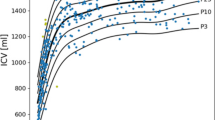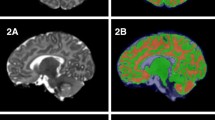Summary
We devised a three dimensional method for the accurate measurement of brain volume and applied it to 32 neurologically normal children, 7 children with only mental retardation and 15 children with both mental retardation and motor disturbance. In the group of neurologically normal children, the total brain volume increased from 723 cm3 to 1407 cm3 in order of age. The correlation ratio between the total brain volume and age was significant (P<0.0001). The values of the total brain volume and the developmental curve were similar to those of the total brain weight of normal children previously reported. The combined volume of the cerebellum, the midbrain, the pons and the medulla also increased from 76 cm3 to 200 cm3 in a manner similar to that of the total brain. The correlation between total brain volume and head circumference was significant (P<0.0001). In the group of children with mental retardation, the total brain volume was relatively smaller than that of neurologically normal children. In the group of the children with mental retardation and motor disturbance, 10 out of 15 cases showed values below — 2 SD of those of neurologically normal children. The values of the total brain volume were each less than — 3 SD in 3 cases whose head circumferences were each more than — 3 SD. Our method for the direct measurement of brain volume based on serial CT scans may be useful for the accurate examination of brain development.
Similar content being viewed by others
References
Meese W, Lanksch W, Wende S (1976) Diagnosis and postoperative follow-up studies of infantile hydrocephalus using computerized tomography. In: Lanksch W, Kazner E (eds) Cranial computerized tomography. Springer, Berlin Heidelberg New York, pp 424–429
Fukuyama Y, Miyao M, Ishizu T, Maruyama H (1979) Developmental changes in normal cranial measurements by computed tomography. Dev Med Child Neurol 21:425–432
Pedersen H, Gyldensted M, Gyldensted C (1979) Measurement of the normal ventricular system and supratentorial subarachnoid space in children with computed tomography. Neuroradiology 17:231–237
Dufresne CR, McCarthy JG, Cutting CB, Epstein FJ, Hoffman WY (1987) Volumetric quantification of intracranial and ventricular volume following cranial vault remodeling: a preliminary report. Plast Reconstr Surg 79:24–32
Gault D, Brunelle F, Renier D, Marchac D (1988) The calculation of intracranial volume using CT scans. Child's Nerv Syst 4:271–273
Gooskens RHJM, Gielen CCAM, Hanlo PW, Faber JA, Willemse J (1988) Intracranial spaces in childhood macrocephaly: comparison of length measurements and volume calculations. Dev Med Child Neurol 30:509–519
Breiman RS, Beck JW, Korobkin M, Glenny R, Akwari OE, Heaston DK, Moore AV, Ram PC (1982) Volume determinations using computed tomography. AJR 138:329–333
Coppoletta JM, Wolbach SB (1933) Body length and organ weights of infants and children. Am J Pathol 9:55–70
Author information
Authors and Affiliations
Rights and permissions
About this article
Cite this article
Hamano, K., Iwasaki, N., Kawashima, K. et al. Volumetric quantification of brain volume in children using sequential CT scans. Neuroradiology 32, 300–303 (1990). https://doi.org/10.1007/BF00593049
Received:
Issue Date:
DOI: https://doi.org/10.1007/BF00593049




